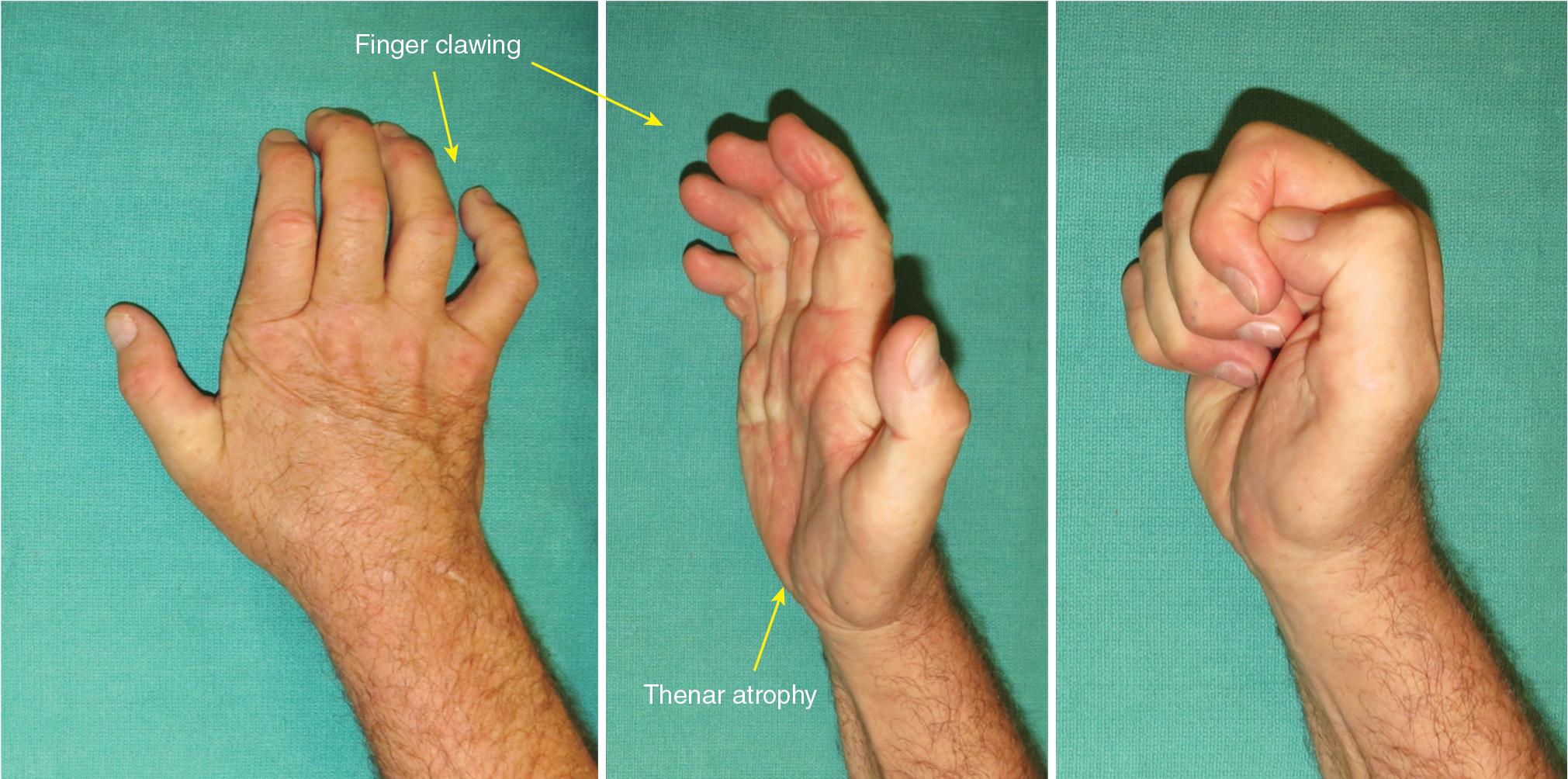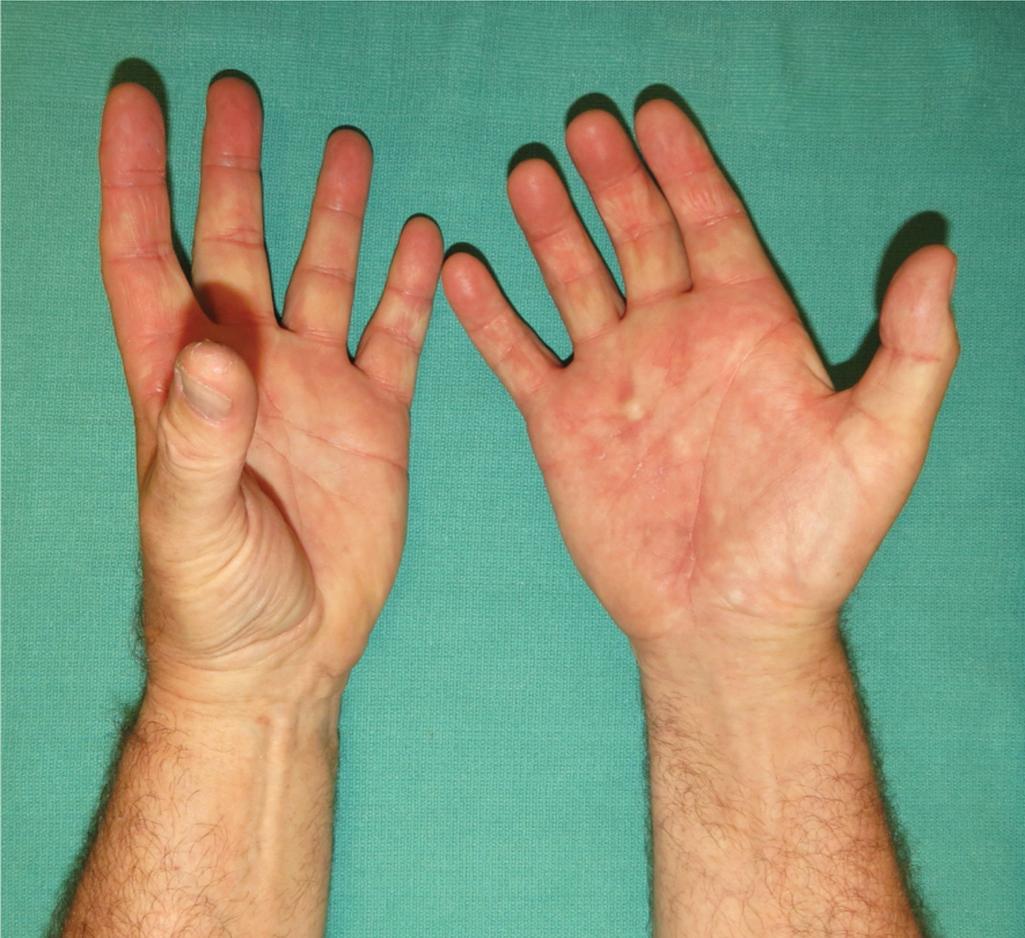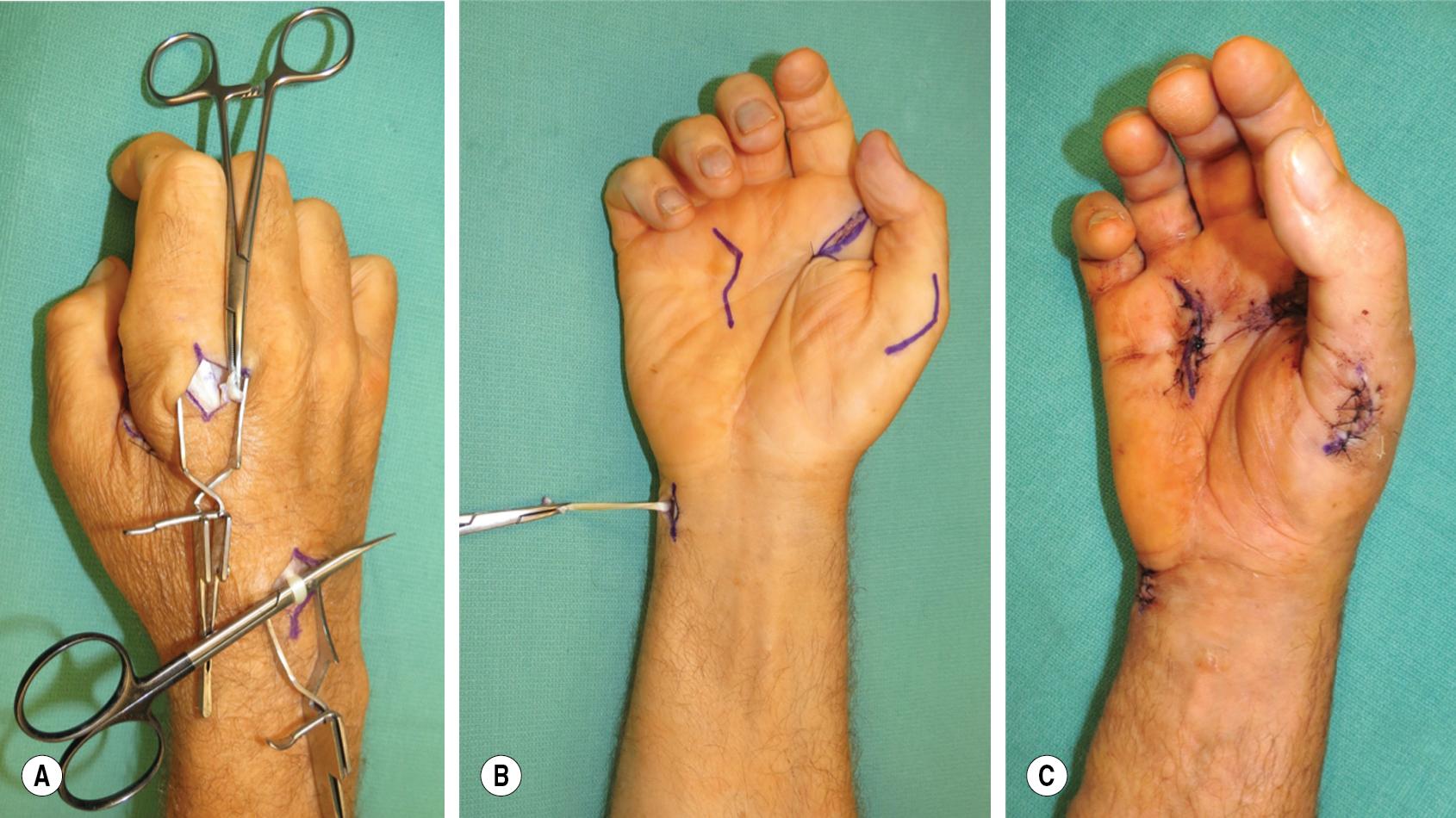Physical Address
304 North Cardinal St.
Dorchester Center, MA 02124
Tendon transfers may be indicated to restore specific functions in patients with combined nerve injuries and resultant motor function loss with no expected recovery.
Combined upper extremity nerve deficits typically result from severe trauma to the arm or after spinal cord injuries. Patients typically have profound disability, significant scarring, and limited remaining muscle tendon units.
Another indication is high nerve lacerations that do not recover before the deterioration of muscle motor endplates (at around 18 months) and are not candidates for nerve transfer.
Deficits will depend on which nerves have been damaged. Common injury combinations include low median-ulnar, high median-ulnar, high ulnar-radial, and high median-radial ( Table 67.1 ). Low median-ulnar palsy is a common combined injury from lacerations of the distal volar wrist ( Figs. 67.1 and 67.2 ).
| Injury | Deficits | Reconstruction Goals | Available MTUs |
| Low median-ulnar | Hand intrinsics (thenar, hypothenar, interossei/lumbricals) | Key pinch Thumb opposition Prevention of finger clawing Coordinated interphalangeal flexion |
BR, wrist and finger extensors PT, PL, FCR, FCU, FDS, FDP, FPL |
| High median-ulnar | Hand intrinsics All FDS and FDP FCR, FCU, PL, PT |
All of above plus: Simple finger flexion |
BR, wrist and finger extensors |
| High median-radial | BR, ECRL, ECRB, ECU, FCR PL, PT, FDS, FPL Radial FDP Thenar muscles except adductor pollicis and deep FPB Radial lumbricals |
Wrist stability Thumb opposition Grip Thumb and finger extension |
FCU (typically after wrist arthrodesis) Ulnar FDP Hypothenar muscles |
| High ulnar-radial | Hypothenar Interossei and ulnar lumbricals Finger and wrist extensors FCU, ulnar FDP |
Wrist extension Finger and thumb extension Key pinch Ring and small finger flexion |
PT, PL, FCR, FDS Radial FDP |


Depending on the patient’s level of function, tendon transfers may facilitate wrist, finger, or thumb flexion and extension; thumb opposition and pinch; or prevention of finger clawing.
Surgical reconstruction must be individualized to each patient to manage specific functional goals and may not fit a prescribed set of tendon transfers.
Before surgery, the tissues must be in equilibrium, with all wounds and fractures healed. Any edema should be resolved and all joints must have full passive range of motion (ROM).
Donor muscle tendon units must be of grade 4/5 strength or greater. Loss of one strength grade after transfer is typical.
Joint contractures unresponsive to occupational therapy may need to be released simultaneously or in a prior procedure. Transfers involving the adductor pollicis may benefit from a first webspace deepening or Z-plasty.
Severe tissue scarring, which may limit the excursion of transferred tendons, may restrict reconstructive options.
Finger and wrist joint contractures should be released before tendon transfers.
Loss of sensation is common in combined nerve injuries. If return of protective sensation is not anticipated or procedures to restore sensation are not possible, tendon transfers are not indicated.
Patient cooperation is critical for tendon transfer success. Any patient who cannot comply with the postoperative rehabilitation course should not undergo tendon transfer.
Patient expectations must be discussed pre-operatively. For these severe injuries, no tendon transfer will re-create a normal hand.
The goal of the physical examination is to determine the patient’s current abilities and functional deficits and evaluate remaining active muscle tendon units (MTUs) available for transfer.
Examination should take place over several visits to adequately observe active motion and ensure that any spontaneous recovery and adaptive functional recovery has plateaued.
Wrist and finger joints must be evaluated to ensure full passive motion.
The available muscles with active function will depend on the individual level and combination of injuries and may not follow a predictable pattern.
Strength grading based on the British Medical Research Council (BMRC) must be documented pre-operatively. MTUs that do not achieve grade 3 strength are not candidates for transfer.
If the median nerve is spared, the presence of the palmaris longus (PL) tendon can be confirmed by having the patient touch the thumb and little finger with the wrist in flexion. The PL tendon is usually palpable on the palmar aspect of the wrist, on the ulnar side of the flexor carpi radialis (FCR) tendon.
If the patient sustained fractures during the injury, obtain radiographs before tendon transfer to ensure fracture union.
Magnetic resonance imaging (MRI) is not needed to ensure tendon continuity; these should be ensured with a thorough physical examination.
The pathways and branches of the median, radial, and ulnar nerves have been illustrated previously (see Chapter 63, Chapter 64, Chapter 65, Chapter 66 ).
Tendon transfers are performed with the patient placed in supine position with an upper arm tourniquet and a regional block or under general anesthesia.
Surgeons comfortable with the wide awake local anesthesia no tourniquet (WALANT) technique may choose to perform the surgery using local anesthesia; a large volume of local anesthetic may be needed to adequately infiltrate the hand and forearm.
The upper extremity is outstretched on a hand table.
This injury combination is frequently the result of a volar laceration across the distal wrist.
Careful attention during the physical examination should ensure that all of the remaining MTUs are clinically functional, because any penetrating injury to the median and ulnar nerves at the wrist may also lacerate the extrinsic finger and wrist flexors.
Reconstructive goals (with our preferred reconstruction techniques):
Key pinch (extensor carpi radialis brevis [ECRB] to adductor transfer; see Chapter 65 )
Thumb opposition (extensor indicis proprius [EIP] to abductor pollicis brevis [APB] opponensplasty; see Chapter 63 )
Treatment of finger clawing and coordinated interphalangeal joint flexion (flexor digitorum superficialis [FDS] transfer to correct claw deformity; see Chapter 65 )
If the FDS has been lacerated, then the brachioradialis (BR) or extensor carpi radialis longus (ECRL) may be transferred to the radial lateral bands with a four-tail tendon or fascia lata graft. The authors prioritize FDS, then BR, and finally ECRL for donor MTUs to prevent clawing so the patient does not lose radial wrist extension when the ECRB is transferred for thumb adduction.
An FDS lasso procedure may also be used to correct clawing ( Fig. 67.3 ).

If both the median and ulnar nerves are not functional, the loss of extrinsic finger and wrist flexors creates a much greater disability than a low injury.
In this palsy, the hand may also be completely insensate, which will limit the utility of tendon transfers.
Reconstructive goals (with our preferred reconstruction techniques):
Key pinch (ECRB to adductor transfer; see Chapter 65 )
Thumb opposition (EIP to APB opponensplasty; see Chapter 63 )
Finger flexion (ECRL to flexor digitorum profundus [FDP])
Thumb flexion (BR to flexor pollicis longus [FPL]; see Chapter 64 )
Treatment of finger clawing and coordinated interphalangeal joint flexion (metacarpophalangeal [MCP] capsuloplasty; see Chapter 65 )
Become a Clinical Tree membership for Full access and enjoy Unlimited articles
If you are a member. Log in here